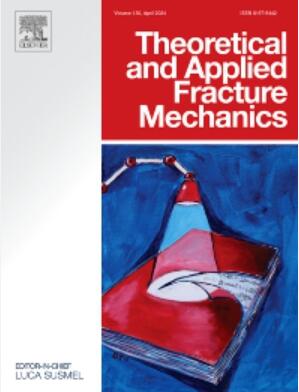Fatigue crack extension and acoustic emission response law of 316L austenitic stainless steel by hydrogen charging
IF 5.6
2区 工程技术
Q1 ENGINEERING, MECHANICAL
引用次数: 0
Abstract
To better understand the crack propagation behavior of 316L austenitic stainless steel in hydrogen environments, fatigue tests were conducted at three different stress levels on both untreated and electrochemically hydrogen-charged samples. Acoustic emission (AE) monitoring was performed throughout the testing process. The results indicate that both the hydrogen environment and stress are primary factors in reducing the fatigue life of 316L austenitic stainless steel, with a synergistic interaction that accelerates material failure. Hydrogen charging alters the fatigue fracture mechanism of 316L stainless steel, increasing the randomness of the crack extension path due to the increasing number of secondary cracks in hydrogen-charged samples. During fatigue fracture, the energy release rate of acoustic emission signals exhibits a linear positive correlation with the fatigue crack propagation rate. Under lower stress conditions, hydrogen-charged samples exhibit a higher fatigue crack propagation rate, with hydrogen serving as the primary influencing factor. A quantitative characterization model for acoustic emission parameters, suitable for hydrogen embrittlement environment but not affected by fatigue average stress, was developed to compute the fatigue crack propagation rate. This study reveals the fatigue crack propagation behavior and damage mechanisms of hydrogen-charged 316L austenitic stainless steel.
316L奥氏体不锈钢充氢疲劳裂纹扩展及声发射响应规律
为了更好地了解316L奥氏体不锈钢在氢环境中的裂纹扩展行为,对未经处理和电化学充氢的316L奥氏体不锈钢试样进行了三种不同应力水平的疲劳试验。在整个测试过程中进行声发射(AE)监测。结果表明:氢环境和应力是降低316L奥氏体不锈钢疲劳寿命的主要因素,两者协同作用,加速材料失效;充氢改变了316L不锈钢的疲劳断裂机制,充氢试样中二次裂纹数量增加,增加了裂纹扩展路径的随机性。疲劳断裂过程中,声发射信号的能量释放率与疲劳裂纹扩展速率呈线性正相关。在较低应力条件下,充氢试样具有较高的疲劳裂纹扩展速率,其中氢是主要影响因素。建立了一种适用于氢脆环境且不受疲劳平均应力影响的声发射参数定量表征模型,用于计算疲劳裂纹扩展速率。研究了充氢316L奥氏体不锈钢的疲劳裂纹扩展行为和损伤机理。
本文章由计算机程序翻译,如有差异,请以英文原文为准。
求助全文
约1分钟内获得全文
求助全文
来源期刊

Theoretical and Applied Fracture Mechanics
工程技术-工程:机械
CiteScore
8.40
自引率
18.90%
发文量
435
审稿时长
37 days
期刊介绍:
Theoretical and Applied Fracture Mechanics'' aims & scopes have been re-designed to cover both the theoretical, applied, and numerical aspects associated with those cracking related phenomena taking place, at a micro-, meso-, and macroscopic level, in materials/components/structures of any kind.
The journal aims to cover the cracking/mechanical behaviour of materials/components/structures in those situations involving both time-independent and time-dependent system of external forces/moments (such as, for instance, quasi-static, impulsive, impact, blasting, creep, contact, and fatigue loading). Since, under the above circumstances, the mechanical behaviour of cracked materials/components/structures is also affected by the environmental conditions, the journal would consider also those theoretical/experimental research works investigating the effect of external variables such as, for instance, the effect of corrosive environments as well as of high/low-temperature.
 求助内容:
求助内容: 应助结果提醒方式:
应助结果提醒方式:


